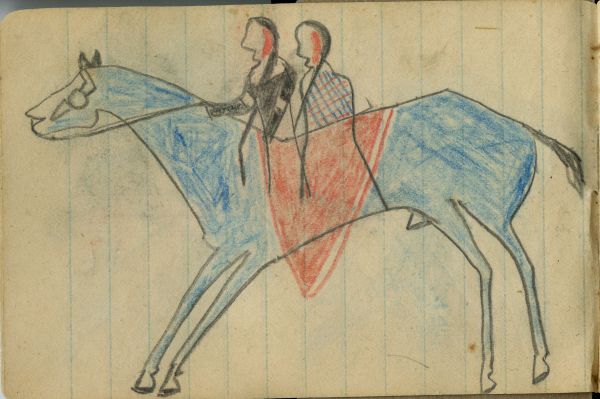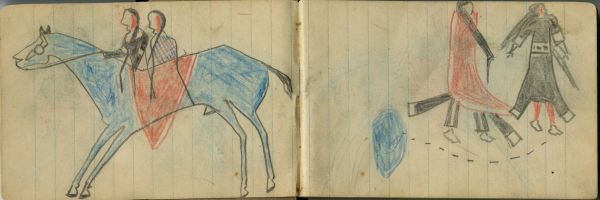COURTING: Man and Woman Ride a Blue Stallion
Ethnographic Notes
Horizontal COURTING: Man and Woman Ride a Blue Stallion The blue horse fills the page, and the couple are small in proportion. One red trade cloth blanket with undyed selvedge edges covers both of their lower bodies. Both have red facepaint along the left vertical hairline, from above the ear to the jaw. The man holds the reins. His long braid is wrapped with otter fur or another tie, extending it. His dark cloth shirt has German silver armbands just above each elbow. The woman wears a shawl or blouse of red and blue plaid. One of the woman�s braids also shows on her shoulder. The blue horse, with uncolored face or white �blaze,� resembles the blue roan of Nokota horses. The horse wears a silver headstall that also appears in the Wild Hog-KSHS ledger. The horse�s rear end is higher than its front. Details include uncolored hooves, erect ears, genitalia, and short tail. Blue horses appear often in ledger art, including the 1879 Dodge City ledger notebooks. Castle McLaughlin and Butch Thunder Hawk curated an exhibit at Harvard University�s Peabody Museum based on a ledger book that included blue roan horses. They wrote this about the blue horses depicted in that ledger: �Lakotas favored blue roans as war horses, as their color indicated the strength and speed of the sky powers.� Some of the 1879 Dodge City men who created these drawings were of Lakota descent, close allies of Lakotas or had Lakota wives. Contemporary Nokota horses descend from these horses: �The Nokota horses of North Dakota are descended in part from animals that Sitting Bull and other Lakotas surrendered to the U.S. military at Fort Buford in 1880. Although blue roan is a rare color, it is still dominant among Nokota horses� (McLaughlin and Thunder Hawk). This 2013 exhibit �Wiyohpiyata: Lakota Images of the contested West� centers around an 1860s Lakota ledger captured by the U.S. Army after the defeat of Custer at Greasy Grass. The ledger is the �Half Moon� ledger book, MS Am2337, Houghton Library, Harvard University, gift of Harriet J. Bradbury, 1930.

